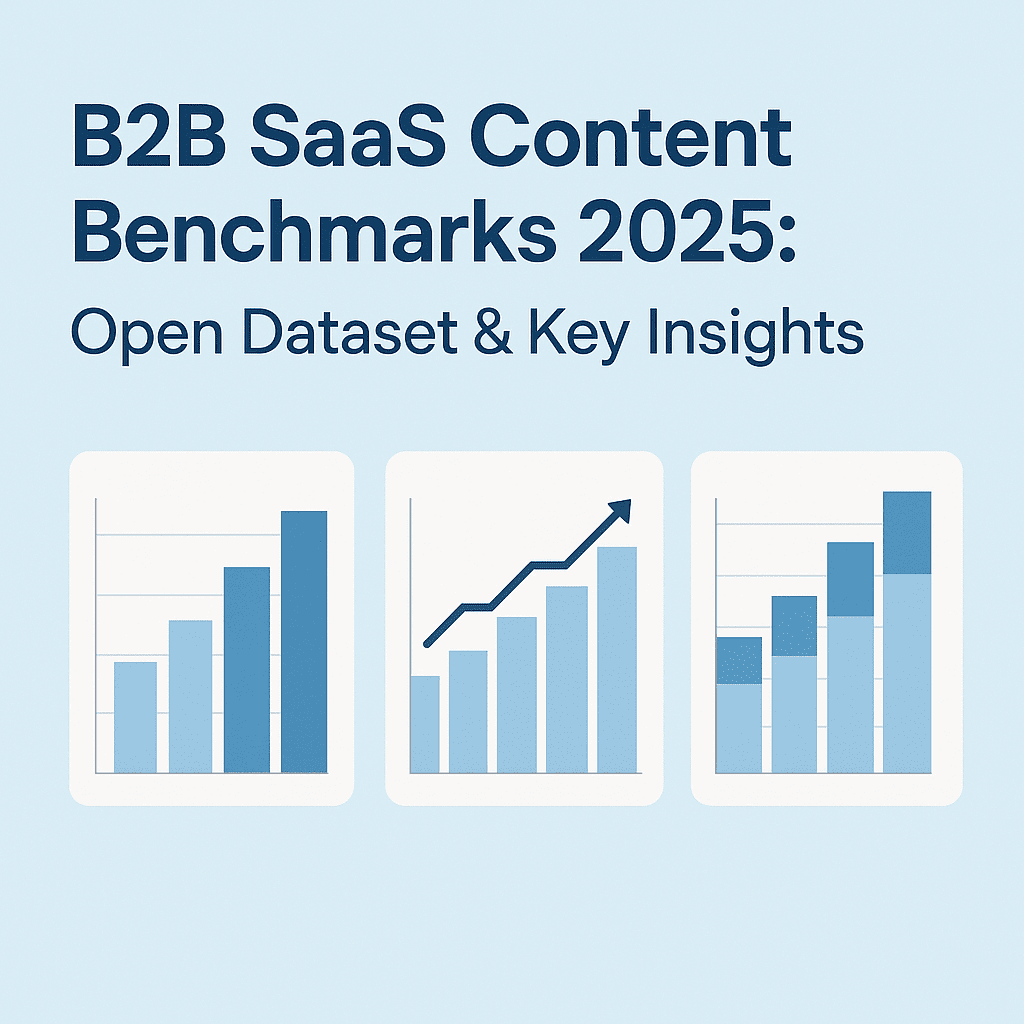Why Do Benchmarks Matter?
In today’s AI-first world of B2B SaaS content marketing, having fresh benchmark data can anchor your strategy and establish authority. Journalists and bloggers love new numbers and evidence-backed insights as they lend credibility to your content and help you gauge performance against industry norms.
Below, we dive deep into B2B SaaS content benchmarks for 2025 ranging from how often to post, to what percentage of content actually ranks, click-through rates by content intent, how long SEO takes, the conversion impact of content audits, and even how Google’s new AI search overviews are shaking things up.
Use these insights to refine your strategy and see the following posts for further guidance:
Table of Contents
Posting Cadence: How Often B2B SaaS Brands Publish Content
One of the first questions content teams ask is “How often should we post?”
Consistency and frequency do matter. In fact, 55% of content marketers say that posting content frequently had a positive impact on search rankings.
Regular publishing keeps your audience engaged and signals freshness to search engines.
How frequent is frequent?
Industry surveys show that almost half of marketers (43%) publish new content several times per week, and at least once a week is considered the bare minimum to stay relevant. This aligns with earlier blogging research for example, Orbit Media’s annual blogger survey finds about 24% of bloggers post weekly, with smaller segments posting daily or multiple times a week.
Only a minority publish monthly or less often.
💡 The takeaway: A steady drumbeat of content (ideally weekly or better) is the norm among active B2B SaaS marketers.
Maintaining a consistent cadence often means planning ahead. Roughly 46% of content marketers have their content calendar scheduled 2–4 weeks in advance. This buffer ensures you can keep publishing even when spontaneous priorities or vacations arise.
And it’s not just about quantity! Quality and strategy matter too.
The Semrush State of Marketing 2023 report noted that the top 3 factors for successful content were thorough audience research, publishing frequency, and content quality.
In short, commit to a regular posting schedule as part of your strategy, but make sure each piece serves a purpose.
What Percentage of Content Actually Ranks in Google?
It’s an open secret in SEO that most content gets little to no organic traffic.
Recent large-scale data backs this fact up as Ahrefs found a staggering 96.5% of pages get zero search traffic from Google. In other words, only a tiny sliver of all published pages ever attract visitors via search. About 1.94% of pages get between 1 and 10 visits a month, and the remaining ~1.5% of pages (out of 100%) receive more than 10 monthly visits.
This means the vast majority of content fails to rank meaningfully (a sobering benchmark for content marketers).
Why do so many pages languish with no traffic? Often it’s due to lack of search demand or extreme competition.
If a topic has no one searching for it, even the best content won’t get Google visits. On the flip side, highly competitive keywords might be dominated by a few winners while dozens of other articles remain invisible.
This power-law distribution of search traffic is illustrated below:
Another way to look at it is that only 5.7% of newly published pages will crack Google’s top 10 results within their first year. In other words, fewer than 1 in 20 pages achieve first-page rankings in year one. The rest either take longer or never make it.
✏️ Key lesson: Don’t be discouraged if not every blog post you publish becomes a traffic magnet. This is normal. Industry benchmarks suggest it’s often just the top 5–10% of your content that will generate most of your organic traffic (sometimes called the “critical few”). The goal is to improve your odds over time through smart topic selection, quality content, and optimization so that your percentage of ranking content is higher than the average ~3–5%. And importantly, make sure the content that does rank brings real value (and ideally conversions) to capitalize on those wins.
Click-Through Rate (CTR) Medians by Intent: TOFU vs. MOFU vs. BOFU
Not all clicks are created equal.
The likelihood that someone clicks your link in Google’s results can vary greatly depending on search intent, broadly categorized as Top-of-Funnel (TOFU, informational queries), Middle-of-Funnel (MOFU, comparison or consideration queries), or Bottom-of-Funnel (BOFU, transactional or navigational queries).
Understanding CTR benchmarks by intent can help set expectations for your content.
Top-of-Funnel (Informational) queries are broad questions or topics (e.g. “how to improve SaaS onboarding”). Here, users are in learning mode.
These searches often trigger rich SERP features like featured snippets, People Also Ask boxes, etc. that give answers directly on the results page, resulting in lower organic CTRs.
For example, industry data shows informational queries tend to have lower overall click rates because users often find quick answers without clicking. It’s not uncommon for the top organic result on a purely informational query to get significantly less than the ~40% CTR that a #1 result averages overall.
In some cases, an info query might see the first result only getting ~20% of clicks if Google’s snippet already satisfies much of the intent (or if users scatter across many results).
Middle-of-Funnel (Commercial) queries (e.g. “best CRM software comparison”) typically have users evaluating options. These users are more likely to click through to explore details, but they may also shop around multiple sites.
CTR here is somewhat higher than pure informational searches.
A well-optimized result that directly addresses a MOFU query (like an in-depth comparison guide) can capture a solid share of clicks, perhaps in the range of 30% for a top rank since the user needs to visit a site for deeper info.
However, MOFU queries often face competition from ads and aggregator sites, which can temper click-through rates.
Bottom-of-Funnel (Transactional/Navigational) queries (e.g. “Sign up for Profound SaaS” or “Salesforce pricing plan”) are where the user often has a specific brand or action in mind.
Here, click-through rates are highest.
For navigational searches (searching a brand or website by name), users typically click the first result (which is usually the official site) the majority of the time. It’s not unusual to see 50%+ CTR for the first organic result on a navigational or highly transactional query, since the intent is to reach a particular site.
Even lower-ranked results on these queries can see decent CTR because the user is determined to find a specific product or solution.
In short, commercial and navigational searches keep higher click rates since users typically want to visit a specific website.
To visualize this, imagine three bars representing median organic CTR for a top-ranking result by query intent.
The BOFU bar (e.g. a branded query) would be the tallest – perhaps on the order of 50–60% – whereas the TOFU bar might be half of that or less, and MOFU in between. Your actual results will vary, but the rule of thumb is: the more intent to act or find a specific answer, the higher the CTR.
Conversely, the more exploratory the query, the more users may skim results or get answers without clicking.
📋 Implication: When evaluating your own pages’ CTRs in Google Search Console, segment by content intent. Don’t panic if a top-of-funnel blog post has a CTR below 5%. That might be normal if it’s ranking for broad questions with many impressions. By contrast, a bottom-funnel “demo request” page ranking for your product name should be seeing a much higher CTR. Use intent benchmarks to identify where you might improve. For instance, if an informational page has a CTR far below the typical range, you might test a more compelling title/meta to better match the query.
Always aim to align your snippet with the user’s intent to maximize clicks from the SERP.
📓 Side note: According to Databox, 67% of content produced is aimed at TOFU – most companies heavily favor top-of-funnel content. But don’t forget BOFU content, which though smaller in volume, can yield high CTR and conversion potential. A balanced lifecycle content strategy ensures you’re covering all stages of the funnel.
How Long Does Content Take to Rank? (Typical Time-to-Rank)
SEO is often a long game, and one common question is “How long until our blog post ranks on Google?”
Benchmarks show that patience is required. The reality is that the average top-ranking content is older. In fact, the average page in Google’s top 10 results is over 2 years old. Many top results have had time to age, accumulate backlinks, and establish authority.
For new content, reaching page 1 quickly is the exception, not the rule. As noted, only about 5.7% of new pages hit the top 10 within a year of publication. That means 94%+ of content won’t rank in the first 12 months. And among those few that do succeed in year one, most don’t do it overnight.
An Ahrefs study found that the lucky 5.7% typically took between 2 to 6 months to achieve that first-page ranking. In other words, even “fast” SEO victories often still require a few months of traction. Very few pages (<0.3%) rank in under a month for competitive terms.
Why does it take so long?
Google’s algorithms look for signs of trust and relevance via backlinks, user engagement, and content depth (which accrue over time).
Also, Google’s index is vast. It may take time to test and elevate your content to see how it performs.
One interesting (and seemingly paradoxical) finding is despite Google’s emphasis on fresh content, a recent analysis noted 72.9% of pages in the current Top 10 are more than 3 years old. “Freshness” matters for certain queries, but in many B2B SaaS topics, the top results are seasoned veterans.
📓 On a positive note, when your content does finally hit that first page, it’s usually worth the wait (often yielding steady organic traffic over the long term). And remember, only 1 in 20 pages achieves this in a year, so celebrate those wins!
Conversion Lift from Content Audits and Updates
If there’s one low-hanging fruit in content marketing, it’s auditing and updating your existing content. Many SaaS companies focus only on creating new posts, but neglect their older content.
In 2025, smart teams are treating content as an asset that can be optimized over time and the benchmarks show huge upside in doing so.
A content audit involves systematically reviewing your site’s content for quality, accuracy, SEO optimization, and relevance.
The payoff?
Improved rankings and conversions. Consider a couple of real-world examples:
Case 1: Website Admissions Pages Revamp – Oakland Community College undertook a content audit and UX revamp of their admissions content. By streamlining copy, improving readability, and adding clearer CTAs, they achieved a 250% increase in conversions within just 5 weeks of making the changes. (Yes, +250%!). This dramatic lift came from focusing on user-centric improvements essentially making sure the content answered audience needs and guided them to the next step.
Case 2: Landing Page Refresh – Morehead State University audited and updated their campaign landing pages, adding elements like testimonials, better calls-to-action, and differentiators. The result: they attracted 15% more users who spent 14% more time on page, leading to a 22% increase in conversions on that page after the audit-driven updates. A double-digit conversion uptick from tweaking content and layout is significant for any business.
These cases are backed by a broader principle of refreshing and improving content can have a major impact on performance. It’s not just about SEO traffic (though updating content can boost rankings); it’s also about conversion rate.
Often, as your product or messaging evolves, older content becomes misaligned – audits catch these issues. No wonder many content marketers now run audits at least twice per year to keep content and strategy up-to-date.
✏️ Benchmark tip: If you haven’t audited your content recently, you could be sitting on untapped gains. Typical conversion lifts from content audits in various case studies range from modest (~5-10% increases) to very substantial (20-50%+ increases in lead generation or sales from improved pages). Even a 10% lift in conversion due to clearer content or updated information can mean thousands of dollars in revenue for B2B SaaS companies with high-value leads.
💡 Pro Tip: To maximize results, integrate content audits into your lifecycle content strategy. For example, schedule a quarterly or biannual review of key pages and blog posts. Use a content audit checklist to identify outdated info, SEO issues, or UX problems. Then update those pages by adding fresh statistics, improving the headlines, making the call-to-action more prominent and measuring the impact. As the above benchmarks show, these tweaks can directly translate into more conversions and pipeline for your SaaS.
And if you need help, consider bringing in a content audit consultant. An outside expert can provide an objective assessment and strategy to elevate your existing content.
AI Search Overviews and Visibility: The 2024–2025 Shift
No 2025 content discussion is complete without addressing AI’s impact specifically, Google’s AI-generated search overviews (also known as Search Generative Experience, or SGE).
Google began rolling out AI summary answers at the top of search results in 2023–2024. This new feature has been a double-edged sword for content marketers as it can increase your visibility but often at the expense of clicks.
Let’s look at what the data shows one year into this experiment.
According to BrightEdge research, the advent of AI overviews has led to a 49% surge in search impressions (more content is getting seen in the AI summaries), but click-throughs from searches have declined by nearly 30% since AI overviews launched.
In other words, Google is showing your content to more people (in snippets or AI answers), yet fewer are clicking through to your site, presumably because the AI result satisfied their query or deflected the traffic.
This aligns with other studies like early analyses by Ahrefs and others noted a 34–50% drop in clicks on results when an AI overview is present especially for informational queries where the AI can synthesize an answer from multiple sources.
The impact of Google’s AI Overviews (SGE) after one year 👉 Impressions up ~49%, clicks down ~30% for organic results.
More searches now show AI summaries at the top (present in ~11% of queries and rising), which means users may get answers without clicking through.
For B2B SaaS content, this means you might notice your Google Search Console data showing more impressions (your pages are “seen” in AI blurbs) but lower CTR (a perplexing scenario).
It challenges the traditional notion of “ranking #1 = lots of clicks.”
As BrightEdge’s CEO put it, “visibility is no longer just about rankings or clicks; it’s about presence across a new class of interfaces”.
We’re moving into an era where being featured in an AI summary still has branding value (users see your name or content excerpt, which can build awareness or trust), even if they don’t click immediately.
💉 Benchmark anecdote: News publisher MailOnline observed that when AI overviews appeared for a query, their #1 organic CTR dropped from ~13% to below 5% on desktop (and ~20% to ~7% on mobile). That’s a massive decline in visitors for content that still “ranks” #1. They reported an average 50–60% drop in organic clicks for queries with AI summaries. While that example is news-oriented, it highlights how any site can lose traffic when Google’s AI provides the core answer upfront.
What can you do about this?
Simple.
First, track it!
Monitor if your important keywords start showing AI results (Google is expanding SGE coverage). You may need to adjust KPIs like focusing on impressions and brand visibility in addition to clicks.
Second, aim to be the source the AI overview pulls from. High authority, well-structured content may be more likely to be cited by Google’s AI (though there are no guarantees, and sometimes the AI answer is uncredited).
If your content is featured, a user might still click the citation or at least register your brand.
Third, double down on bottom-of-funnel and thought leadership content that users will click into no matter what – e.g., someone isn’t going to sign up for a demo via an AI blurb; they’ll click your site. Ensure those pages are easy to find and ranking well for relevant queries.
The AI overview trend is still unfolding.
The key benchmark is awareness that a 0% CTR search (zero-click search) doesn’t mean your content failed. It might mean Google answered the query with AI or a snippet.
In 2025, success in SaaS SEO will be measured in both traffic and on-SERP presence.
Adapt your content strategy accordingly (for instance, by answering common questions directly on your site and providing compelling deeper content that entices a click for those who want more).
The game is changing, but those armed with data (like the insights above) can evolve and thrive in the new landscape.





